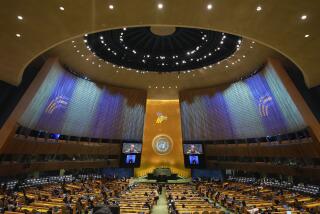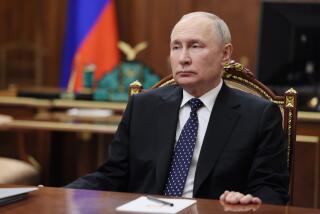Ratify the Comprehensive Test Ban Treaty
- Share via
More than 100 government leaders from around the globe will meet this month at the United Nations to discuss the Comprehensive Test Ban Treaty, an international accord whose goal is to make the world safer by stemming the spread of nuclear weapons.
The treaty has been in limbo for more than a decade. Negotiations on it were concluded at the United Nations General Assembly in 1996, with the treaty calling for the ban of nuclear test explosions for any purpose. It’s been signed and ratified by 154 member countries, including Russia, Japan, South Korea and all of America’s NATO allies.
The United States is one of just nine key nations that hasn’t ratified the treaty. The U.S. Senate can change that — and should do so now. Its ratification and entry into force would immediately bolster the international community’s efforts to stop rogue states from developing and potentially proliferating nuclear weapons.
In 1996, President Clinton was the first world leader to sign the treaty. But the Senate in 1999, after only a brief consideration, rejected ratification of the measure and hasn’t taken up the issue since.
The treaty is an essential tool for dealing with today’s security threats. The age of a superpower nuclear arms race is over. Instead, world leaders must focus on preventing the spread of nuclear weapons to additional states, blocking advances in their nuclear weapons technologies — and not letting nuclear weapons slip into the hands of terrorists.
Countries with nuclear weapons, such as China, India and Pakistan, cannot create advanced nukes without further nuclear test explosions. Without nuclear tests, Iran could not confidently build warheads for delivery by ballistic missiles. By ratifying the treaty, the United States would put pressure on these nations to shelve their nuclear programs and engage more productively with the international community.
To detect and deter nuclear testing, the treaty empowers the United States and the international community with strong inspections authority. The treaty provides for a global network of 337 monitoring stations, many of which are in sensitive locations like Russia and China to which the United States doesn’t have access. Once in force, the treaty would give inspectors the ability to conduct short-notice, on-site investigations of any suspicious sites. That’s an ability the United States does not possess now.
In 1999, opponents of the treaty expressed concern that it would hamper America’s ability to maintain a robust nuclear arsenal. Those worries are now moot. Thanks to technological progress over the last decade, nuclear scientists can determine with high confidence that warheads work without detonating them. Indeed, the United States hasn’t conducted a nuclear test explosion since 1992.
Research has shown that plutonium, the key ingredient in nuclear weapons, is not affected by aging for 85 years or more. Scientific advances have also allowed America’s nuclear scientists to refurbish and modernize existing warheads with “life extension programs.” A September 2009 study from the JASON panel, a group of independent scientists, concluded that the “lifetimes of today’s nuclear warheads could be extended for decades” without explosive testing.
Nuclear experts have argued forcefully against testing. Earlier this year, the head of the National Nuclear Security Administration, Thomas D’Agostino, said that the United States has “a safe and secure and reliable stockpile” and that “there’s no need to conduct underground [nuclear] testing.”
Even some of those who opposed ratification of the treaty in 1999 have come out in favor of the agreement. George Shultz, the secretary of State under President Reagan, has said that his fellow Republicans “might have been right voting against [the treaty] some years ago” but they’d “be right voting for it now.”
After all, the treaty does not hamstring America’s efforts to maintain its nuclear arsenal. President Obama has called for $85 billion over the next 10 years for our nation’s nuclear weapons laboratories — a full 13% increase over the level of spending during President George W. Bush’s administration, and more than enough to get the job done.
By ratifying the treaty, the United States would gain the political and moral leverage to end nuclear testing worldwide. And we’d help establish the kind of robust framework needed by the international community to monitor and deter the nuclear activities of the most dangerous countries.
Now is the time for the Senate to seriously reconsider and approve the test ban treaty.
Hazel R. O’Leary served as U.S. secretary of Energy from 1993-97; Daryl G. Kimball is executive director of the nonpartisan Arms Control Assn.
More to Read
A cure for the common opinion
Get thought-provoking perspectives with our weekly newsletter.
You may occasionally receive promotional content from the Los Angeles Times.










